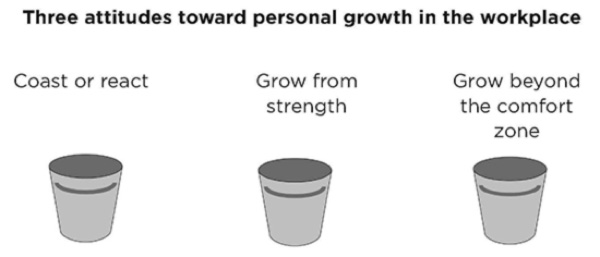Hi Leader,
Many clients and readers of these Keys have told me that they prefer listening to books on Audible rather than reading them, as they can access the content while driving and working out. Thank you for encouraging me to narrate my new book Create New Futures myself. I have just completed the recording, which now is available on Amazon. I'd love for you to have the benefit of applying the ideas, frameworks and tools I share in the book. In whatever format you choose (print, Kindle, Audible), I am confident you will find great value, inspiration and practical ideas you can implement immediately. Here is the teaser I recorded for Audible.
The recording process provided powerful and unexpected revelations. About 40% of the manuscript includes material I have not spoken about previously. The exercise of bringing these concepts to life in my own speaking voice was a transformative experience. I came away filled with gratitude and appreciation for the people who have trusted me, for the teams I have worked with, and for the precious opportunity to further my own learning by teaching and leading others. I am even more excited than before about the quality of the practical and inspirational content I have integrated into Create New Futures, and about its ability to inspire you to create your next new future.
Would you please help me get the word out about this opportunity by forwarding this email to your friends and those in your professional networks? You also can help by adding a five-star review of the book on Amazon.
"Create New Futures is transformative. A fantastic author explains how great actions lead to breakthroughs. Aviv Shahar reminds me of the guy who's told, 'That idea is global' and replies, 'No, it's much bigger than that.' Read this book and change the world before the world changes you."
- Alan Weiss, PhD, author, Million Dollar Maverick, Million Dollar Consulting, and over 60 other books
This Key includes an excerpt from Portal 11 (chapters of Create New Futures are called portals) of the book, in which I explore the Three Buckets of Value. The segment focuses on a critical choice that separates those who are merely successful in achieving their goals from those who are able to exceed their goals and surprise themselves and others with their achievements. It's a choice you face daily in both small and big ways.
The true story below frames this choice. As you read it, I encourage you to pause to reflect on how the one-in-ten choice is relevant for you, and how you choose to respond to your opportunities. For example, how strategic and proactive are you in pursuing your personal development goals? What competencies and skills you are developing at the moment? How will they help you achieve the future you envision?
Are you the 1 person in 10 who chooses this path?
Peter is a talented manager. Because he tends to be understated, his demeanor can hide his talent and intelligence. Here is how our coaching conversation about his professional development unfolded, and how I used the three buckets to help Peter turn his deliberations into forward action.
Peter: "The feedback from my boss confirms that she is pleased with the significant progress I've made with my team in achieving our goals. To demonstrate that I am a strong candidate for the next level executive role, she proposed that I pursue three growth opportunities:
- Become a more assertive driver and closer.
- Be the 'bigger person' by taking the initiative, presenting my point of view, leading the conversation, and stepping up to challenges by re-framing setbacks as opportunities.
- Accelerate my project work by bringing issues to closure more quickly.
"How would you advise me to approach these suggestions?"
Well, Peter, your boss has given you very specific and concrete feedback. You now are at a crossroads: rest on your laurels and ignore the opportunities, or rise to the challenge to build on your achievements and improve your performance."
Peter's reply was immediate. "I definitely want to apply myself in these opportunity areas."
"Congratulations! Do you realize that by making this one simple decision to take action, you have separated yourself from 50% of people in the workforce? Let me explain by putting your choice into context."
Here is the context I described. Out of every ten people in the workforce, five are doing nothing about their development and growth. They merely are reacting, coasting, or even drifting from day to day without the focus of a development agenda. This paradigm says, "I am coming here to do a job. Do not ask me to do more than that." It is shocking that 50% of employees bring no self-directed focus to their personal growth, failing to recognize that the work environment itself presents a fantastic development opportunity.
Four people out of ten choose to embrace the mental model of development and growth. They build on their core strengths and previous successes, augmenting and capitalizing on behaviors and skills that already have delivered dividends for them. Frankly, this is a smart approach. Why? We know that we learn best and fastest by expanding from our core strengths, by applying the virtuous cycle of success and positive experience, and by doing more of what we do well. We also know that it is easier to elevate good performance to excellent performance than it is to convert bad performance to mediocre performance. That, in a nutshell, is the strengths-based approach to development. Sadly, many people stop their personal development journey at this point. However, it is not the end of the road. To continue the journey from here requires a different choice.
Only one person in ten decides to go beyond the strengths-based approach to personal development. These individuals essentially are saying in their own ways, "I intend to challenge myself to proactively and strategically seek opportunities that catalyze my growth and development." That is the one-in-ten choice. It is driven by entrepreneurial energy that is not content with the status quo. The one-in-ten person believes that staying in place actually is going backwards, and therefore is restless enough to generate movement that expands into the unknown and the uncertain.
I draw the three buckets here to elucidate the point of this thinking frame:

"Which bucket represents your choice, Peter?
"You can decide to follow the well-trodden path of those who decide to join the 'four in ten' group, or you can opt to take the path less traveled, the one chosen by the 'one in ten' group. The difference between the people in these two groups is that those in the latter recognize that certain experiences are acquired only when you seriously challenge yourself. The 'one in ten' choice implies exposing yourself to situations that require you to operate outside your comfort zone. It is a choice to embrace growth opportunities that at times push you against your natural inclination and a declaration of readiness to take the initiative, and navigate in uncertain terrains where the rewards can be significant, though success is not guaranteed.
"What's the unifying denominator for the 'one in ten' professionals?
"In my experience, what differentiates the 'one in ten' is that they are self-starters, driven from the inside out. Although they embrace external stimuli when available, they are not dependent on them for their growth. They love learning and growing more than they love the safety of playing only on their home turf."
"If I don't challenge myself out of my comfort zone, I get bored," Peter observed.
"That mindset determines how you approach your growth and development plan. I respect your choice, Peter. As your trusted adviser, I would not be critical if you had said, 'Life is good, and I am happy to be in the four-in-ten group for now.' However, I would point out that engaging me to help you as a leader inside that context may be a misallocation of resources. Your decision validates the point of our work together. We now can bring laser focus to your opportunities and develop a concrete action plan so that both of us can hold you accountable."
At this point, our conversation shifted to address the three growth opportunities Peter decided to embrace. Peter's aptitude and eagerness to embrace discomfort and risk provided a broader range of alternative strategies and tactics for him to deploy. He was carving out his own one-in-ten path.
© Aviv Shahar

